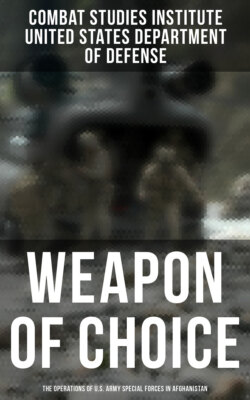Читать книгу Weapon of Choice: The Operations of U.S. Army Special Forces in Afghanistan - Combat Studies Institute - Страница 10
На сайте Литреса книга снята с продажи.
Developing the SOF Campaign at SOCCENT, Tampa, Florida
ОглавлениеDesignated the “supported” headquarters for the war against Afghanistan, CENTCOM asked MG Geoffrey Lambert, USASFC, to provide several staff officers to prepare the SOF campaign. Lambert chose two officers and two NCOs to assist SOCCENT in developing its regional counterterrorist plan. This plan was intended to “look beyond” the near-term deployment of SOF to the region for action in Afghanistan to formulate concepts for subsequent activities. COL Manuel “Manny” Diemer, Lambert’s chief of staff and the team leader, was accompanied by CPT Paul Colter (pseudonym), a former 3rd SFG officer who had worked in the CENTCOM AOR.
When the SF command team arrived at SOCCENT headquarters in Tampa, Diemer was surprised to find his colleague, COL Mike Findlay, at work there also. Findlay, the special operations commander from the Joint Forces Command, Norfolk, Virginia, had a task much like his. “I’m here to give staff guidance and training to the SOCCENT staff,” Findlay told him. Diemer soon discovered why they needed additional support. COL Eric Stanhagen, deputy commander, SOCCENT, told Diemer in their first meeting that “We’ve put all our J5 (the regional contingency planners) guys into our J3”—that is, the planning cell was disbanded and the personnel moved into the current operations section. The headquarters had become focused on “the tactical war in Afghanistan,” Diemer relayed to MG Lambert; “There is no special ops strategy for the whole region.” Lambert directed Diemer to help the SOCCENT staff expand its efforts into a long-range theaterwide plan.
Twenty-four hours later, Diemer and his team produced a doctrinally correct “classic sevenphase unconventional warfare plan” outlined on yellow legal pads. In particular, the plan included Lambert’s concept of “operationalized engagement” to ensure that the noncombat exercises in the region were integrated into CENTCOM’s counterterrorist and counternarcotics campaigns. Shortly afterward, LTC Darrin Matteson (pseudonym), from the SOCCENT Special Plans Office, presented the new plan to Franks, the warfighting general of the theater, and his principal staff in a formal briefing. Matteson explained how this proposed UW plan was “synchronized with the CENTCOM four-phase plan” to remove the Taliban government from power in Afghanistan. Diemer remembered that Franks did not ask a single question during the briefing, which he later learned was “a first” for the CENTCOM commander. At the end of the presentation, Franks said to Matteson, “I understand everything you said . . . I understand all the acronyms . . . your plan is approved.” Diemer flew back to Fort Bragg the next day to “gear up” USASFC’s resources to make the SOCCENT campaign plan into reality.
